How does a Zanussi washing machine work?
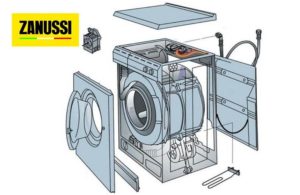 The internal “stuffing” of all front-facing cameras is almost the same. There are minor differences, but the general principle of operation of components and components remains unchanged. Using an example, we will analyze the structure of a Zanussi washing machine and tell you how the main parts interact with each other.
The internal “stuffing” of all front-facing cameras is almost the same. There are minor differences, but the general principle of operation of components and components remains unchanged. Using an example, we will analyze the structure of a Zanussi washing machine and tell you how the main parts interact with each other.
Elements of the machine and body structure
It is not difficult to understand how the Zanussi washing machine works. A description of all the main components and components is presented in the instructions. The wiring diagram is shown there. If we talk about the “basic set” of elements of an automatic machine, these are:
- motor;
- tank (depending on the model, it can be metal or plastic);
- drum;
- drain pump;
- electronic module;
- shock-absorbing system (springs, dampers);
- frame;
- pressure switch;
- inlet solenoid valve;
- a heating element;
- bearing unit.
Knowing how a washing machine works, you can diagnose and repair it yourself without resorting to the help of a technician.
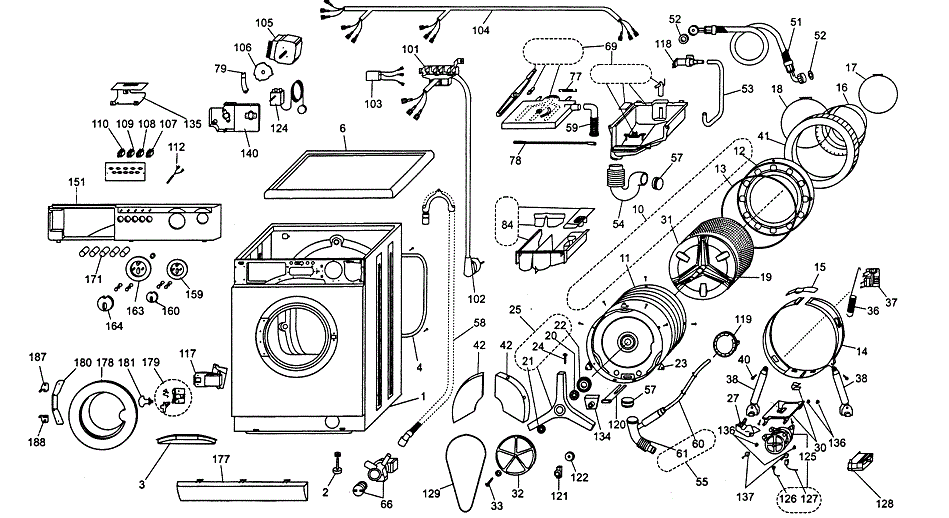
If the operation of any basic element is disrupted, the washing machine will not be able to perform its functions. Understanding where each part is located and what it is responsible for, it is easier to notice any signs of a malfunction, carry out diagnostics and repair the automatic machine.
Zanussi washing machines have a characteristic feature in comparison with front-facing washing machines of other brands - this is the body. It can be disassembled into two halves at once: front and back. In fact, the machines do not have separate side walls; they are combined with the front and rear panels.
To “halve” the Zanussi body, you need to remove the plastic plugs on the sides and bottom.There are bolts hidden behind them - they need to be unscrewed. Next, as usual, the top cover is removed. There are 4 more screws hidden under it (two on each side). After removing all the screws, it is easy to separate the “front” and “back” of the washer.
What happens inside the case?
If all parts and sensors are in working order, the automatic machine works flawlessly. Each node performs its own functions, the process is controlled by the main control module, the “brain” of the washing machine. The electronic unit sets the sequence of operations, receives and transmits signals, and ensures uninterrupted interaction of internal elements.
If you disassemble the body of the front-facing machine, the first thing that will catch your eye is the tank. It is a large plastic container. The reservoir is supported by shock absorbers and springs.
The drum is “hidden” in the plastic tank. The “centrifuge” is made of stainless steel and has a porous surface. The container rotates thanks to a pulley connected through a shaft and a cross. The wheel, in turn, is spun by the engine via a drive belt. Actually, the machine washes the clothes due to the speed it gains.
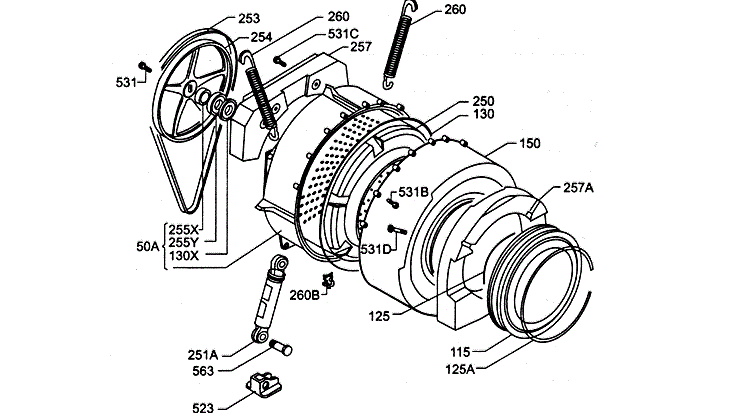
The algorithm for operating an automatic machine during a standard wash is simple. After the user selects a mode and presses the “Start” key, the control module opens the inlet valve. Water begins to flow into the system. The pressure switch controls the degree of filling of the unit and, when the required volume of liquid is reached, transmits a signal to the “brain” that it is time to stop filling. Next, the block activates the heating element, whose task is to heat the liquid to a given degree.
The “brain” of the washing machine alternates the stages of the cycle, and at the end it commands the pump to drain the water.
This is exactly how each cycle in the machine is performed.When you turn on additional options, such as soak or prewash, the program steps change slightly, but the meaning remains the same. The control module controls the operation of all elements and transmits “commands” in a timely manner so that the machine functions without failures. To study the structure of an automatic machine in more detail, you need to consider each component and part separately.
Interaction of machine containers
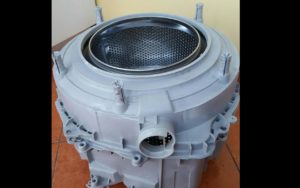 The most voluminous element of the washing machine is the tank. In Zanussi automatic machines, the main tank is made of plastic, due to this it is possible to reduce the final cost of the equipment. In some models of other brands, the tank is made of stainless steel, which is undoubtedly more reliable, but the cost of the machine also increases significantly. Usually the tank is placed horizontally in the machine. You can find models in which it is located at a slight angle, but this is rare.
The most voluminous element of the washing machine is the tank. In Zanussi automatic machines, the main tank is made of plastic, due to this it is possible to reduce the final cost of the equipment. In some models of other brands, the tank is made of stainless steel, which is undoubtedly more reliable, but the cost of the machine also increases significantly. Usually the tank is placed horizontally in the machine. You can find models in which it is located at a slight angle, but this is rare.
A porous metal container is “hidden” in the tank into which dirty laundry is loaded. Water first enters a plastic tank, where it is mixed with detergent, heated, and poured through the holes into the drum. In addition to micro-holes, there are special protrusions on the drum walls - this improves the quality of washing.
If you follow all the rules for operating a Zanussi washing machine, the tank and drum will be safe and sound. Systematic overloading of the washing machine can lead to damage to the elements. In addition, metal objects left in clothing pockets can “pierce” the tank: keys, paper clips, screws, bobby pins. The rotation of the “centrifuge” can be blocked by a bra bone stuck between the metal and plastic walls.
Parts responsible for heating
The water in the tank is heated to the user-specified temperature thanks to the heating element. The element is located immediately below the drum, at the back. To access the tubular heater, you must disassemble the housing, move the back and remove the drive belt.
Washing machine heating elements are among the most frequently broken parts.
It’s easy to explain why heaters often fail: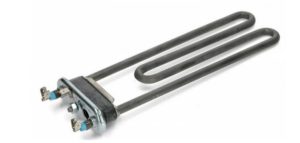
- The heating element is constantly in contact with hard water, so a thick layer of scale forms on it;
- limescale causes overheating of the heating element, which leads to burnout of the part.
Therefore, in order to avoid damage to the tubular heater, it is important to install a filter for softening hard tap water at the entrance to the apartment or washing machine. It is also necessary to periodically clean the “insides” of the washing machine from scale using special means.
If we talk about the power of the heating element on Zanussi machines, the elements usually consume 1800-2200 W. Experts do not recommend frequent washing in hot water - this can lead to premature failure of the tubular heater. If you need to run several cycles in a row with water heating to 60-90°C, it is important to let the automatic machine “cool” for 30-60 minutes between washes.
Motor and motor of the machine
The washing machine drum rotates thanks to an electric motor. The motor, through the drive belt, transmits “revolutions” to the pulley, and the wheel accelerates the “centrifuge” to the desired speed. This ensures high-quality washing and excellent spin. The “life” of an engine depends on several factors, the first of which is the type of engine.
Zanussi washing machines have collector motors.
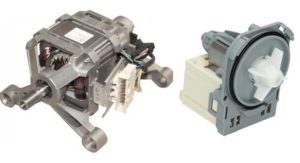 Brushed motors are cheaper than inverter motors, but they are inferior to the latter in several characteristics.“Collectors” are less reliable, react sharply to power surges, and require periodic maintenance, in particular, replacement of brushes. However, if you connect the washing machine to the network through a stabilizer and promptly diagnose the motor, there will be no problems with the operation of Zanussi.
Brushed motors are cheaper than inverter motors, but they are inferior to the latter in several characteristics.“Collectors” are less reliable, react sharply to power surges, and require periodic maintenance, in particular, replacement of brushes. However, if you connect the washing machine to the network through a stabilizer and promptly diagnose the motor, there will be no problems with the operation of Zanussi.
The engine is considered the “heart” of the washing machine. It starts working immediately after starting the washing program. Depending on the selected mode, the “brain” regulates the number of engine revolutions, sometimes slows down the speed, and when spinning, gives the command to accelerate as much as possible.
The weak point of commutator motors is the electric brushes. Over time, after about 4-5 years, the carbon rod wears off and the elements have to be replaced. It’s not difficult to install new brushes; you can do the repairs yourself without inviting a professional.
Control board
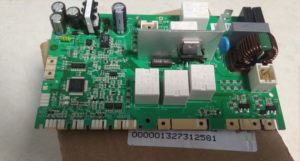 The user sets the desired washing parameters by pressing keys on the control panel. You can select the desired mode by rotating the selector knob, activate additional functions, adjust the temperature and the number of revolutions. The “tidy” is connected to the main electronic module.
The user sets the desired washing parameters by pressing keys on the control panel. You can select the desired mode by rotating the selector knob, activate additional functions, adjust the temperature and the number of revolutions. The “tidy” is connected to the main electronic module.
Zanussi's main control board consists of semiconductor elements: microcontroller, triacs, capacitors, triggers, thyristors, resistors. Communication with the main parts and components of the machine is carried out via electrically conductive paths.
Modern Zanussi machines can independently carry out diagnostics, identify faults in the system and notify the user of breakdowns.
It is the control board that ensures the sequential execution of cleaning programs. All available washing algorithms and parameters are pre-recorded in the electronic module circuit. This gives the user the opportunity to launch the required mode without errors using the dashboard.
Some washing programs are carried out strictly according to the algorithm recorded in the “intelligence”. Individual modes can be adjusted - changing the water heating temperature and spin speed.
Other fillings of Zanussi cars
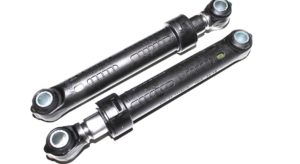 To fully understand how the Zanussi washing machine works, you should consider the additional details that are present in each model. Although these components have a “secondary status,” the normal functioning of equipment without them is impossible. What elements are we talking about?
To fully understand how the Zanussi washing machine works, you should consider the additional details that are present in each model. Although these components have a “secondary status,” the normal functioning of equipment without them is impossible. What elements are we talking about?
- Door seal. Serves to seal the washing machine. The rubber band is stretched over the outer edge of the drum and the body.
- Shock-absorbing elements. They are necessary to suppress vibration emanating from the rotating drum. Without springs and dampers, the machine would jump during every wash.
- Hatch locking device. This is a safety mechanism that securely locks the door. After activating the lock, you will not be able to accidentally open the washing machine.
The washing machine will not begin to draw water into the tank until the UBL operates.
- Drive belt. Without it, the electric motor will not be able to spin the drum. The motor transmits impulses through an elastic band to a pulley, which accelerates the “centrifuge” to the desired speed.
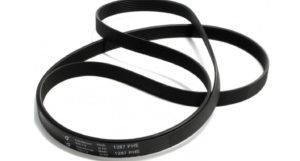
- Counterweights. These are heavy concrete blocks that are necessary to give the machine stability. Due to the mass of stones, the washing machine is able to withstand the highest speed rotation of the drum. Without weights, the machine will constantly wobble during washing, which will lead to damage to the body and some of the internal elements.
- Door. Without the hatch, it would be impossible to put laundry in the machine.
- Powder receiver. The detergent drawer is divided into three sections.Water first passes through the tray, mixes with the powder, and then flows through the pipes into the tank.
- Pipes. A kind of “circulatory system” of a washing machine. Water circulates through them inside the machine. Hoses connect the dispenser and tank, pump and drum. If the tubes become clogged, the machine may stop working.
In fact, there is nothing complicated in the design of an automatic machine. Difficulties may arise with repairing the control board. To work with electronics, you still need some experience and knowledge. Otherwise, you can repair the machine yourself. Knowing which element is responsible for what, it is not difficult to identify the cause of the problem and try to fix it.
Interesting:
2 reader comments
Add a comment Cancel reply
Categories
Washing machine repair


For buyers

For users

Dishwasher

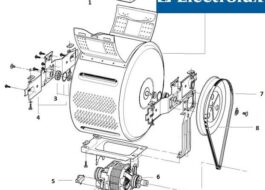


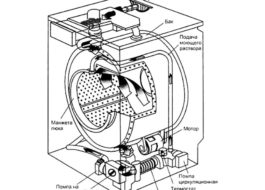












It was very interesting and useful. Thank you!
Thank you.